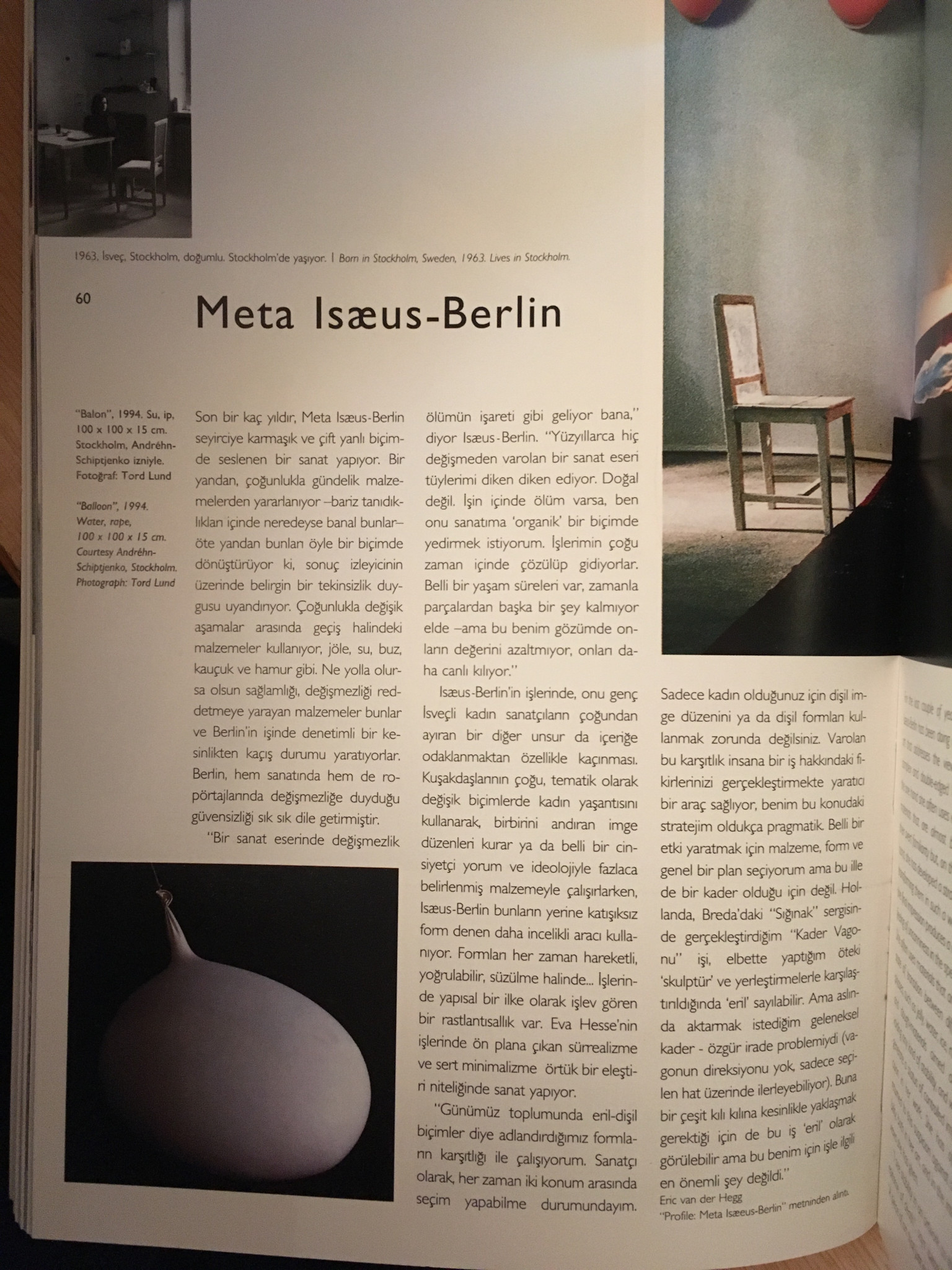Meta Isæus-Berlin
For the last couple of years, Meta
Isæus-BeHin has been doing a kind of
art that addresses the viewer in a
complex and double-edged way. On
the one hand she often uses everyday
materials that are almost banal in
their overt familiarity but, on the other
hand, she has developed a strategy for
transforming them in such a way that
the final impression produces a distinct
feeling of uncanniness in the spectator.
She often uses materials that are in a
state of transition between different
phases, such as jelly, water, ice, rubber
and dough-materials aimed at avoiding
any kind of stability, and which
generate a status of controlled impre-
cision in her work. She has often
returned to this suspicion against sta-
bility, both in her art, and in the inter-
hand, she has developed a strategy for
transforming them in such a way that
the final impression produces a distinct
feeling ofuncanniness in the spectator.
She often uses materials that are in a
state of transition between different
phases, such as jelly, water, ice, tubber
and dough-matehals aimed at avoiding
any kind of stability, and which
generate a status of controlled impre-
cision in her work. She has often
returned to this suspicion against sta-
bility, both in her art and in the inter-
views she has given.
”l see stability
in an artwork as the
epitome of death”,
says Isæus-BeHin.
”A piece of art that
just exists over the
centuries in an
unchanged fashion
gives me the creeps.
It’s unnatural. If
death is present I
prefer to incorporate
it in my own
art in an ‘organic’ fashion.
Most of my pieces disintegrate over
time. They have a life-span built into
them, and with time they are reduced
to fragments, but that doesn’t diminish
their value in my eyes-it just makes
them more true to life.”
Another characteristic feature of
Isæus-Berlin work, which separates her
somewhat from much of the younger
Swedish female art of today, is the
conscious lack of focus on content
While many of her peets thematically
work through female experience in
various ways, with univocal imagery as
the primary vehicle, or with materials
that are over-determined by a certain
gender interpretation and ideology,
Isæus-Belin uses the finer tool of pure
form instead. Her forms are always
mobile, malleable, floating…
Containing
an element of chance which
functions
as a constitutive principle
in her work.
She creates an art which
references
both surrealism and the
implicit critique of hardcore
minimalism, prominent in the works
of Eva Hesse.
I’m trying to work
with the already
existing assumptions
of what is
regarded as masculine versus
feminine forms in today’s society. As an
artist, I’m always in the position of
being able to choose between the two
positions. You are not bound to use
female imagery and female forms just
because you are a woman. This
existing opposition furnishes you with a
creative insttument to realize the ideas
that you have about a work and my
strategy in that regard is quite prag-
matic. I select materials, forms, and a
general lay-out in order to produce a
certain effect, not because I am pre-
destined to do so. The ”Destiny Wagon”
that I made for the “Shelter”
exhibition in Breda, Holland can of
coutse be seen as ‘masculine’ com-
pared to other sculptures and installa-
tions I have done. But what I really
wanted to get across was the tradi-
tional problem of destiny versus free
will (the wagon does not have a
steering wheel, it just moves on in the
direction that was originally chosen),
and since that needed a kind of exac-
titude and precision, it can be under-
stood as masculine, even if it is irrele-
vant to me.”
Meta Isæus-Bedin wotks with a
desetted kind of imagery that isolates
itself from many of the tendencies of
contemporaty Swedish art. Her pieces
are free from many of the aspects of
sexuality, violence, and politics often
found in today’s ‘post-Foucauldian’ art
and art criticism. Although the roots of
her pieces are found in domestic situ-
ations, she works unrelentlessly to neu-
tralise any ideological or literary
meaning.
Eric van der Hegg
Excerpt from “Profile: Meta Isæeus-Berlin”.
“Chair Beside Bed”,
1996. Wood,
water, textile,
280 x 160 x 75 cm.
Couttesy Andréhn-
Schiptjenko, Stockholm.
Photograph: Per-Anders
Allsten

